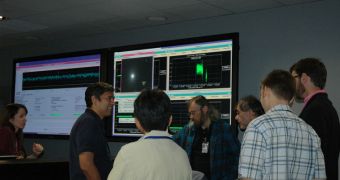Mission controllers at the NASA Jet Propulsion Laboratory (JPL), in Pasadena, California, are excited to announce that the EPOXI spacecraft will be conducting a close flyby of the Comet Hartley 2 tomorrow, November 4.
The last engine firing and course correction maneuver took place yesterday, November 2, at around 11 am EDT, when the spacecraft was sent commands to ignite and burn its engines for 6.8 seconds.
This changed EPOXI's velocity by about 1.4 meters per second, or 3 miles per hour, mission controllers say. It is now on path to fly within a few hundred kilometers of its target.
Analyzing Hartley 2 could provide researchers with new data on how these celestial bodies operate. This particular one was discovered only some 24 years ago, and has been little studied as a result.
What's peculiar about it is that it releases a lot of material as it flies, roughly the same amount as a comet six to seven times its size. Astronomers have no clear explanation for why that happens at this point.
“I've worked the Stardust flyby of comet Wild 2 and the Deep Impact encounter with comet Tempel 1, and I have never seen a comet flit around the sky like this one,” explains JPL mission navigator Shyam Bhaskaran.
“We needed to make this burn to re-locate the spacecraft for the 700-kilometer [about 435 miles] flyby distance,” the scientist adds.
“Hartley 2 is one-seventh the size of comet Tempel 1, but it releases almost the same amount of material into the space environment. These jets can act as thrusters and actually make small changes to the comet's orbit around the Sun,” says Mike A'Hearn.
The researcher, who holds an appointment at the University of Maryland, is the principal investigator of the EPOXI mission. The new flyby will be the fifth when a spacecraft images a cometary nucleus.
Hartley 2 passed closest to Earth on October 20, before towards the Sun. The mission was extended in mid-flight, after already visiting 9P/Temple. Its name comes from two extended mission components.
The first is the extrasolar planet observations, called Extrasolar Planet Observations and Characterization (EPOCh); and the second is the current flyby, called the Deep Impact Extended Investigation (DIXI).
In addition to EPOXI, a large number of space- and ground-based telescopes are trained on Hartley 2 as well, including the Hubble and the Wide-fields Infrared Survey Explorer (WISE) telescopes.
Astronomers hope that these studies will make it easier for them to understand the role the comets played early on in the development of the solar system.
This mission is managed by the JPL for NASA's Science Mission Directorate, at the agency's Headquarters in Washington DC.
The main contractor for the construction of the spacecraft was awarded to Boulder, Colorado-based Ball Aerospace & Technologies Corp.

 14 DAY TRIAL //
14 DAY TRIAL //